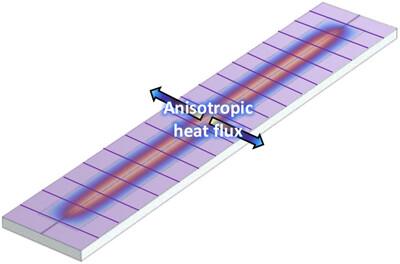Obtaining Orthogonal Thermal Conductivity Components from Anisotropic Thin Films Using the Pseudo Steady-State 3ω Method
IF 2.9
4区 工程技术
Q1 MULTIDISCIPLINARY SCIENCES
引用次数: 0
Abstract
Directional characterization of thermal conductivity is essential for the development of technologies, including electronic devices, as it allows for the optimization of heat management. With the miniaturisation of electronics, thin films of materials a few nanometres to a few microns thick are commonly used. Only a few methods exist to measure the orthogonal in-plane components of thermal conductivity in anisotropic films, and one that has recently been demonstrated is the pseudo steady-state 3ω method. In this work, a computational model of pseudo steady-state 3ω measurement chips has been developed and evaluated. Thin films of an anisotropic material are modeled with respect to the measurement of in-plane thermal conductivity in orthogonal directions. Through modeling the measurement of an anisotropic polymer film, it is found that this method can be remarkably accurate in obtaining the orthogonal components of thermal conductivity. The measurement error, caused by heat leakage at the edge of the measurement area, can be as low as 4%. The dependence on material and measurement parameters is discussed, and it is shown that the model can also be used to correct for the heat leakage at the edge of the measurement area.

用伪稳态3ω法从各向异性薄膜中获得正交导热系数
热导率的定向表征对于包括电子设备在内的技术发展至关重要,因为它可以优化热管理。随着电子产品的小型化,通常使用几纳米到几微米厚的材料薄膜。目前,测量各向异性薄膜中热导率的正交面内分量的方法很少,最近被证明的一种方法是伪稳态3ω方法。在这项工作中,建立了一个伪稳态3ω测量芯片的计算模型并进行了评估。利用正交方向上的面内热导率测量对各向异性材料薄膜进行了建模。通过对各向异性聚合物薄膜的测量建模,发现该方法可以非常准确地获得导热系数的正交分量。由测量区域边缘的热泄漏引起的测量误差可低至4%。讨论了对材料和测量参数的依赖关系,并表明该模型也可以用于校正测量区域边缘的热泄漏。
本文章由计算机程序翻译,如有差异,请以英文原文为准。
求助全文
约1分钟内获得全文
求助全文
来源期刊

Advanced Theory and Simulations
Multidisciplinary-Multidisciplinary
CiteScore
5.50
自引率
3.00%
发文量
221
期刊介绍:
Advanced Theory and Simulations is an interdisciplinary, international, English-language journal that publishes high-quality scientific results focusing on the development and application of theoretical methods, modeling and simulation approaches in all natural science and medicine areas, including:
materials, chemistry, condensed matter physics
engineering, energy
life science, biology, medicine
atmospheric/environmental science, climate science
planetary science, astronomy, cosmology
method development, numerical methods, statistics
 求助内容:
求助内容: 应助结果提醒方式:
应助结果提醒方式:


